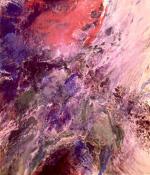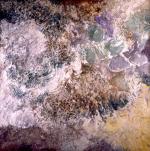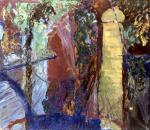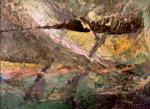 Amethyst River, 1969
Amethyst River, 1969
 White Sea, 1981
White Sea, 1981
 Courtyard of the Baths, Evening, 1987
Courtyard of the Baths, Evening, 1987
 Estuary No.3, 1995
Estuary No.3, 1995
 Clouds and Moon, 1996
Clouds and Moon, 1996
The Journey of John Hubbard by Douglas Hall
Contemporary critical taste seems to admire those paintings that are most clearly fleurs du mal, as witness the immense prestige of Francis Bacon. John Hubbard, for all his admiration for Bacon, is not of that persuasion. Nor could he be, given the serene and happy life he has made for himself in a specially beautiful corner of England. Since the death of Bacon many other strategies have been devised, more often in other media than painting, for expressing, or exploiting, the stressful and frenetic atmosphere of the late 20th century. Many other painters besides Hubbard of similar age or similar way of thinking or living have found themselves crowded off the stage by a new type of artist adept at playing on the raw nerves of the time. Not that Hubbard articulates such feelings. Some complain of neglect, but that would not be his way. Besides, John Hubbard has always commanded respect, and sufficient opportunities to show his work. This exhibition is just another welcome demonstration that underneath the vagaries of the most publicised contemporary art events, the production of painting of beauty and essential optimism goes on. Achievement of serenity in life or art does not presuppose ideal good fortune. One has only to think of the poverty of Monet, the family circumstances of Bonnard, the isolation of Morandi, all of whose work has in common that it produces joy. It is a matter of choice whether or not the reaction to contemporary miseries should take the form of despair, alienation and self-disgust. As a result of too exclusive attention to the contemporary, these feelings have too often been seen as the only reaction possible. As we shall see, Hubbard takes a much longer view.
Like the late John Schueler, Hubbard is an American formed in the ambience of New York abstract expressionism, who came to Europe and eventually found in the landscape and skyscape of Britain the materialisation of the visual sensations he had been evoking in his abstract paintings. Schueler found his parallel in the stormy skies of the Argyll coast, where he eventually bought a house (as a result his work, well known in Scotland and the USA, is hardly known at all in England). Their experience is the confirmation of the near impossibility of non-figurative painting. The core history of Hubbard's work, since he arrived in England in 1960, has been the attempt to bring into focus together two superimposed imageries, one paint-led, the other perception-led. As this long time-span suggests, the process can never be wholly completed, and has taken many twists and turns. The most recent paintings, the content of this exhibition, seem to me to come nearer to a resolution than ever before.
To describe the twin sources of Hubbard's work in this way may seem too limiting. Of course the artist's response to the paint as he applies it, and his response to his perceptions of the outside world, are neither of them mechanical responses, but are dependent on his state of consciousness at the time, the fine tuning of his intuition, the store of associations he can bring to bear. At the age of 65, Hubbard's associational memory, like his experience, is vast. It may be useful at this point to rehearse some of the sources of the visual memory which have made him the painter he is today. First of all Hubbard is a man of education, in literature, art history, architecture and music. This sort of background is often supposed to lead to eclecticism, and may do so. But what it does inevitably bring is a self-consciousness which the act of painting cannot stand for itself alone but resonates and echoes through those other spaces of the mind where other intelligence is being evaluated, other strategies being devised. Feeling this, it was impossible for Hubbard, as it was impossible for Robert Motherwell, to accept denial of the past, or of western cultural history, that was demanded by the avant-garde American schools of the 50s and 60s. Fortunately Hubbard was also an eager student of oriental art, and had his opportunity to pursue it when posted to Japan during the Korean war. This culture may not have represented such a threat to the American avant-garde as that of Europe. Nevertheless an artist such as Sam Francis, who came too close to spreading oriental embroidered silks before our eyes, had to suffer the same suspicious attitude towards the beautiful that Hubbard later encountered.
Hubbard's affinity however was not so much with Francis as with the quiet Americans Mark Tobey and Morris Graves. Both had a knowledge of Taoist and Zen philosophy and following them, Hubbard has been readier to cite both the sayings and the paintings of Chinese tradition than to quote any western guru. Tobey, long resident in Europe before his death, found his affinities at last with such 'painters of silence' as Jules Bissier and Italo Valenti. It is possible to group around these artists, in retrospect if not in historical circumstance, others whose context may have been widely different but for whom reticence, limitation of means, time for distillation, the pursuit of balance and transparency, were essential to their achievement of transcendence and spiritual equivalence. One of these would be Giorgio Morandi, a painter far removed from Hubbard in scale and aspect, but whom he singled out for special admiration when in Rome in 1960. The focus of this sort of creativity in England was the late Jim Ede, and the spiritual atmosphere he created can still be best experienced at the museum he founded at Kettle's Yard in Cambridge. Ede demonstrated how artists as disparate as Ben Nicholson and David Jones could be reconcilable on a metaphysical scale.
It is interesting to speculate whether the course of Hubbard's work could have been different if he had come under Jim Ede's influence when he settled in Britain in 1960. It may be asked what this American, raised on an American scale and the New York way with paint, could have to do with the pieties of Kettle's Yard. One answer is that the size of the picture field, or of the brush-stroke, is not significant when compared with the process of distillation already noted. What joins Hubbard to the 'Edean' view is his refusal of merely contemporary imperatives - to be apocalyptic, degenerative, street-wise, cathartic, single-issue conscious, liberationist or whatever - in favour of very long ones. He has quoted with approval the ancient Chinese Hsei Ho; 'In art, the terms ancient and modern have no place'. This is a formidably difficult position for an artist to take: for a figurative painter it would be crippling. Since our perceptions and associations cannot be the same as those of past centuries, the connecting link must be of an abstract nature. If he is to live up to this self-imposed challenge, this assumption of identity with the past, Hubbard has to purge his work of all contingent elements. The dualism I referred to must be faced at its most basic. The nervous activity of perception must be incarnate in the material body of painting. Together they form a separate and distinct entity. I am tempted to add a third element to make a sort of Trinity - that must be of course the mind of the artist himself.
If I am even half way right about Hubbard's position, he must, to be true to himself, always be an 'abstract' painter. 'Readings' of his completed canvases should never be construable as readings of a particular perception. At some periods of his work he seems to have been ready to depart from this principle, as when he came under the influence of some extremely seductive visual perceptions at the Alhambra and in Seville. Splendid though those paintings are, their reactive character encourages the spectator to make literal interpretations - an activity to which we are all prone but which the most transcendent painters rebut.
All this is not to suggest that Hubbard is wrong in describing himself as a landscape painter. Seeking to distance himself from abstract expressionism by coming to Britain, and at once encountering the St Ives School of abstracted landscape, he could hardly have done other than adopt that terminology even though he resisted absorption into the St Ives club. He is not a view painter but an observer of nature. Only in nature can the depth of perception necessary for his kind of painting be found. He is not usually interested in the long prospect - a rock face or a thicket can provide a better starting point. Starting points of course there must be, and each of them is studied in numerous drawings in pencil and charcoal, and in watercolours. Drawing, in rising order of size, is his medium of translation from the particular to the abstract. Some of the drawings have a strong sense of locality. To submit to a strong sense of locality is a necessity for Hubbard and is the object of his frequent travels. The important thing is that the sense of a new locality should be so absorbed into the painterly blood stream that it issues naturally in a noticeable modification of his painting methods.
In a remarkable even unbroken painting career, there may have been only a few such divisive changes. The first came after 1969 when, under the influence of a visit to Morocco, the long gestural brushstrokes of abstract expressionism finally gave way to the far smaller touches of, say, late Monet. This was not just a technical variation. The change which it signalled could not be more radical, for the brush stroke of the abstract expressionist was indicative of one thing only, personal prowess with the painting arm. The smaller touch by contrast was symbolic of the multiplicity of nature, in microcosm or macrocosm. It would be adaptable equally well to the galactic revelations of the Hubble telescope as it was to the glint of amethysts in the bed of a river, something that Hubbard did actually see in Morocco.
The smaller brushmark was never used to pointillist effect, as Hubbard's affinity was more to late Monet than to Seurat. One thing it did was to assume a more organic appearance, fusing to form skeins and membranes (as in the beautiful White Sea of 1980). In works like this Hubbard's brush mimics matter in its most wonderfully Protean aspect, whether the starting point is water, quartz or plants. We may see suggestions of the mineral, vegetable or even the animal kingdom in the paintings of this order.
Hubbard's visit to the Scilly Isles in 1984 and to Spain in 1987 both moved him in the same direction: to a quite dramatic increase in the size of his units of form. Sometimes is amounts to composing in blocks of colour (Alhambra; Bath Courtyard No.5 1988 or Interior 1986) and in these cases the change is directly related to a switch of subject-matter - from an abstraction of perception to a readable record of perception. It occurred when Hubbard was trying to grasp the effect of the magical interior architecture of Moorish Spain. At other times, both in Spain and the Scillies, it was gardens that absorbed him - as they absorb him at home. Gardens provided the same detailed encounter with nature that Hubbard had looked for elsewhere, but in flaunting their colourful and leafy forms before him they succeeded in diverting his concern with the raw material of nature, and turning him towards more flamboyant creations. So architecture and flowers had a broadly similar effect on the fabric and weave of Hubbard's painting. It was for a long time more akin to the abstracted landscapes of the St Ives School than to the abstracted essence of nature that is in my opinion Hubbard's special quality.
It is probably these paintings of the 1980s that have exposed Hubbard to some criticism as being decorative or escapist. In a lengthy introduction to his exhibition at the Yale Center for British Art in 1986, the late Peter Fuller felt obliged to rebut the idea that Hubbard was '... lurching towards naturalism; rather, his confidence in his vision is such that he no longer feels it to be threatened by these more material presences'. The paintings are sumptuous, and at a less censorious critical period would probably have won universal approval. Yet in my opinion they form no more than an episode in Hubbard's career. The 'lurch to naturalism' certainly did not occur, and the present exhibition may be proof that Hubbard did not want it to.
The trigger for a retreat from that direction was a number of visits to the west coast of Scotland in the last few years. The landscape of the far west of Scotland, away from the mountain massifs, is a landscape of detail and multiplicity, of water running over shining stones, little dark peat hags and tussocks, gorse and heather mimicking the gnarled trunks of olives, small pools and sudden furious spates. Above all is the mercurial light, the clouds and squalls and sunbursts roaming about the country like wild beasts long since exterminated there. This was perfect Hubbard country, and the canvasses that have resulted I incline to think are the finest he has ever done. Hubbard was particularly interested in the boundaries between land and sea, or between river and sea, hence the generic name of 'estuarial' paintings he has given to this group. The paint is once again broken up, reflecting the myriad facets of his perception. Provided with a key word, estuarial, it is natural for the viewer to look for a watery theme, which serves well enough to focus attention on the long trails of paint that meander across some of the canvasses. But Hubbard resists the idea that these show water running in defined channels, which could be represented from various points of view. Only perhaps in the earliest canvas of the series is the temptation to see actual running water irresistible, though the painting is a little diminished if one yields to it.
Hubbard's colour in these early paintings is oddly reminiscent of the disordered paint work of the elderly William McTaggart, painting on the west coast of Scotland a century ago. Moving from his Pre-Raphelite origins, and never having heard of abstract art, McTaggart strove to come to terms with sand and water as the primal elements of the scene and to find equivalents in a primal way of painting. His figures of children seem to be born out of the sand and the seaweed and be of the same substance. There are no figures in Hubbard's canvases but their elemental mutations and combinations suggest the ever-present possibility of life being there. We should not be seduced by the pale and delicate colours of some of these canvases. They are strong and sinuous and seem to hold within themselves this latent power to metamorphose.
In a second but roughly contemporaneous group of these paintings from Scotland, the 'nocturnes', the metamorphosis seems to be under way. Night has overcome the sand and sea, pitching us into a stormy spooky world of unknown shapes, unknown terrors which the presence of a full or crescent moon does nothing to disarm. Is Hubbard throwing us a lifeline by representing something we can recognise? We do more than recognise these realistic heavenly bodies. To see them takes us back instantly to the world of the English Neo-Romantics in the 1940s, still a potent force in English art when Hubbard arrived here. In a sense, then, Hubbard has completed a circle with these paintings. This exhibition, quite small as it is, exposes the principal sources of John Hubbard's work with clarity and felicity.
© Douglas Hall, 1996